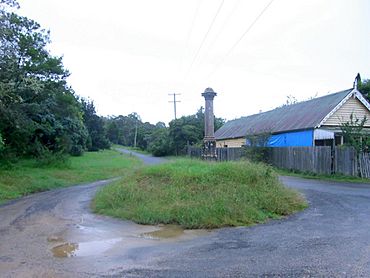Nerrigundah, New South Wales facts for kids
Quick facts for kids NerrigundahNew South Wales |
|
|---|---|

Former store, the last building in Nerrigundah village centre (since destroyed by fire in 2019) and memorial obelisk to Constable Miles O'Grady, killed by bushrangers in 1866
|
|
| Time zone | AEST (UTC+10) |
| • Summer (DST) | AEDT (UTC+11) |
| LGA(s) | Eurobodalla |
| State electorate(s) | Bega |
| Federal Division(s) | |
Nerrigundah is a small place and a former village in southeastern New South Wales, Australia. It's located at the start of the Tuross River Valley. This area is about 19 kilometers inland from the town of Bodalla. In 2021, only 40 people lived in the Nerrigundah area.
Contents
Nerrigundah's First People
The Walbanga people, who are part of the larger Yuin group, lived in the Nerrigundah area for a very long time. We don't know exactly how long they lived there. The name Nerrigundah comes from an Aboriginal word. It means 'camp where edible berries grow'.
The Gold Rush Era
Before gold was found, the Nerrigundah valley was used for raising cattle. A man named Thomas Mort from Bodalla owned the cattle run.
Gold was discovered in Nerrigundah on December 23, 1860. George Cook, Joseph Goodenough, and William Crouch found it. This discovery was officially recorded in Braidwood, New South Wales in January 1861. The news of gold brought many people to the area.
Bushrangers Attack Nerrigundah
On April 8, 1866, Nerrigundah was attacked by bushrangers. These were outlaws who robbed people. The famous Clarke brothers, Thomas and John, led the gang.
The bushrangers first stopped people outside of town. Then, they attacked the local store and hotel. During the attack, a new gang member named William Fletcher was shot. He was shot by NSW Police trooper Miles O'Grady. Trooper O'Grady was also shot and later died from his injuries. He was buried in Moruya. Today, a monument stands in Nerrigundah to remember Trooper O'Grady.
Village Life and Gold Mining
Even though people were already mining for gold, Nerrigundah officially became a village in April 1868. The way the village was planned probably followed the paths of the earlier mining settlement. Gold mining continued in the area into the early 1900s.
Later Years and Local Industries
After the gold rush slowed down, Nerrigundah remained a small village. It was supported by local industries. These included cutting timber, collecting wattle bark for tanning leather, and making eucalyptus oil.
Nerrigundah had a sawmill that provided jobs. Many local Yuin people worked there. The company that ran the sawmill also provided houses for its workers. The sawmill stopped operating around the year 2000.
Education and Community
Nerrigundah had a school for many years. It was open from 1863 to 1923. It then reopened from 1959 to 1972. The village also has more than one burial ground. One cemetery was officially opened in 1904.
Bushfire Impact
Nerrigundah was severely affected by bushfires during the 2019–2020 Australian summer. On December 31, 2019, a fire destroyed many buildings. The village hall was lost, along with 20 out of 25 homes. Sadly, one resident also died.
Even after this terrible event, the number of people living in the Nerrigundah area actually increased. This happened between the 2016 and 2021 censuses.


